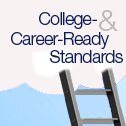Gaps in high school graduation between students of color and white students have narrowed, but still persist, reports the U.S. Department of Education this week.
Progress is being made in closing the gaps in achievement among students at the low-end of the performance spectrum, but disparity is widening among those at the high-end, according to research from the Education Trust.

One strategy to address this equity gap is to expose students to rigorous, college-aligned courses, such as Advanced Placement.
College Board, which administers the AP program, is now entering year two of its “All In” campaign to encourage more students who have shown an aptitude for success in an AP class to sign up. As part of that initiative, high schools are offered a free, Web-based tool, “AP Potential,” to identify students likely to excel in AP based on their PSAT/NMSQT scores.
White students and those from high-income families are much more likely to enroll in an AP course than underrepresented minorities, the Education Trust finds. There are over 640,000 low-income students and students of color missing from AP, meaning they have demonstrated the ability to succeed in AP courses based on their PSAT score but are not signed up for a class.
Speaking at the SXSWedu conference in Austin last week, Nicole Young, associate director for social justice at the College Board, reported that about 20 percent of high schools that administer the PSAT/NMSQT are using AP Potential. To spread the word about the availability of AP to qualified students, College Board sent out 70,000 letters to parents of African-American and Latino parents and received 1,000 responses. An email campaign leveraged the star power of NFL’s Richard Sherman and Shonda Rimes, a television writer and producer, to reach out to 38,000 students with AP Potential and 40,000 educators. College Board also launched a social media campaign that has attracted followers on Twitter, said Young.
AP is offered in 71 percent of all high schools and reaches 91 percent of students, according to Marni Bromberg, a senior research associate at Education Trust. So the gaps in participation are not just about access. This points to a “within school problem” where all students are not equally encouraged to stretch themselves by enrolling in a college-level course, she said.
Many students of color with AP potential attend schools in which AP classes are offered. They just aren’t stepping forward. For example, while 20,203 African-American students took an AP exam in 2014, there were 17,737 who did not, and 13,468 of those were in schools with courses offered, Young reported.
It can be difficult for students of color to not have many other students in an AP class who look like them, said Bromberg, referencing the video, “I am BCC” with interviews from minority students in relatively affluent Bethesda, Md.
There are schools, however, where participation in AP matches the demographics of the school. The College Board has developed a cadre of alumni from AP to serve as ambassadors and reach out to minority high school students about participating in the program. It is also encouraging teachers and counselors to personally invite students into AP courses, to make them feel welcome and confident about participating, said Young.
There are schools where participation in AP matches the demographics of the school and some districts have used innovative strategies.
In Washington state,the Federal Way school district south of Seattle has adopted an “opt out” policy where students are expected to take an AP course unless they decline. Kelly Munn, state field director for the League of Education Voters in Washington, told the audience in Austin that while adoption of the policy was controversial initially, test scores have not gone down as a result of having a larger pool of test takers. Now other districts in the state are considering such a policy, she added.
While College Board does not track schools that have “default enrollment” policies, surveys have found that schools are increasingly removing barriers to taking AP.
According to a College Board AP Participation Survey, which is distributed to schools in the fall, schools were asked if they typically allowed any student to enroll in an AP course, regardless of their prior grades and teacher recommendations. Of those schools that responded to the fall 2014 survey, 47 percent responded “yes,” up from 43.7 percent of schools the previous year and 42.4 percent of the schools that responded to the fall 2012 survey.
Last fall, the College Board posted results on the AP program and AP Potential in its annual report.